|
Battle of Fort Donelson
Other Names: None
Location: Stewart County
Campaign: Federal Penetration up the Cumberland and Tennessee Rivers (1862)
Date(s): February 11-16, 1862
Principal Commanders: Brig. Gen. Ulysses S. Grant and Flag-Officer A.H. Foote
[US]; Brig. Gen. John B. Floyd, Brig. Gen. Gideon Pillow, and Brig. Gen. Simon B. Buckner [CS]
| Battle of Fort Donelson |
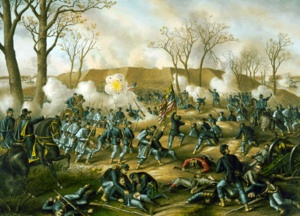
|
| Kurz and Allison (1887) |
Forces Engaged: Army in the Field [US]; Fort Donelson Garrison
[CS]
Estimated Casualties: 17,398 total (US 2,331; CS 15,067)
Result(s): Union victory
Summary: After capturing Fort Henry on February 6, 1862, Brig. Gen. Ulysses
S. Grant advanced cross-country to invest Fort Donelson. On February 16, 1862, after the failure of their all-out attack aimed
at breaking through Grant’s investment lines, the fort’s 12,000-man garrison surrendered unconditionally.
This was a major victory for Brig. Gen. Ulysses S. Grant and a catastrophe for the
South. It ensured that Kentucky would stay in the Union and opened up Tennessee for a Northern advance along the Tennessee and Cumberland rivers. Grant received
a promotion to major general for his victory and attained stature in the Western Theater, earning the nom de guerre “Unconditional
Surrender.” Fort Donelson was part of Gen. Winfield Scott's Anaconda Plan.
Battle of Fort Donelson
A Tennessee Civil War History
| Fort Donelson Battlefield Map |
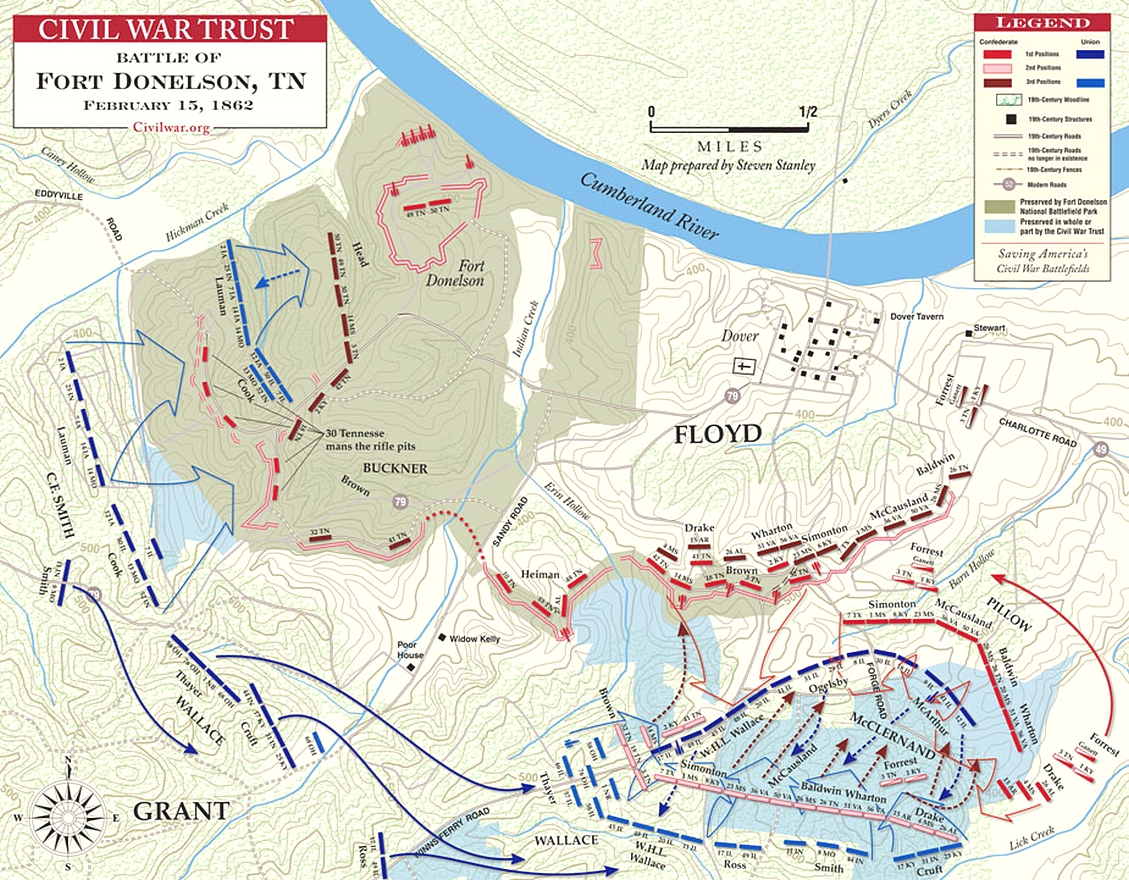
|
| Digitally Enhanced Battle of Fort Donelson Map |
Background:
On February 4-5, Grant landed his divisions in two different locations, one on the east bank of the Tennessee River to prevent
the garrison at Fort
Henry from escaping and the other to occupy the high ground on the Kentucky side to ensure the fall of both Forts Heiman and Henry. After Union Flag-Officer
Foote's gunboats began bombarding the forts, Confederate Brig. Gen. Lloyd Tilghman recalled the troops building Fort Heiman to assist in the defense of Fort Henry. Tilghman soon realized that he
could not hold Fort Henry.
Thus, he ordered his barbette-mounted cannons to hold off the Union fleet while he sent most of his men to Fort Donelson, 11 miles away.
Recommended Reading: Where the South
Lost the War: An Analysis of the Fort Henry-Fort
Donelson Campaign, February 1862 (The American Civil War) (Hardcover). Description: This book presents one of the most
detailed descriptions of the Fort Henry
and Fort Donelson Campaign. The volume describes the preparation, logistics, and the execution of the campaign. The book details
the futile (and brief) defense of the poorly designed Fort Henry. It demonstrates the willingness of General Ulysses Grant, unlike many of his
general officer brethren in the Union Army at that time, to take immediate action against Fort Donelson. Continued below.
It shows some of Grant’s sloppiness in combat situations (as at Shiloh, where he did not bother preparing
a stout defense or at Belmont
when he lost control of his troops), for instance, when he left Fort
Donelson to meet with the naval commander--leaving his army leaderless
at the time when the Confederates attempted a breakout. But the book also well describes his tenacity. After the near breakout,
Grant takes initiative once again. The description of the dysfunctional Confederate command structure (from Albert Sydney
Johnston on down to the commanders on the ground at Fort Donelson) is excellent, although, perhaps, Simon Bolivar Buckner may not have been quite
as ineffective as depicted… A valuable book that warrants being in the library of Civil War buffs.
Battle of Fort Donelson
| Fort Donelson |

|
| The Leaders |
| Fort Henry - Fort Donelson Map |
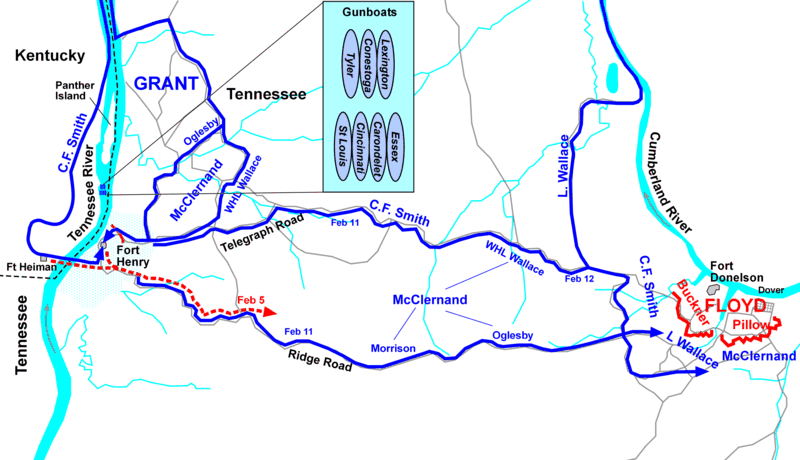
|
| (Click to Enlarge) |
Setting the
Stage
(Right) Civil War Map showing movement from the Battle of
Fort Henry to the Battle of Fort Donelson.
In a joint army-navy operation
a fleet of seven gunboats - four ironclads and three wooden ones -- under Union naval Flag Officer Andrew H. Foote steamed
out of Cairo,
Illinois, on February 2, leading the transports carrying Grant's force.
"No terms except
an unconditional and immediate surrender can be accepted." Ulysses
S. Grant, February 16, 1862
| Fort Donelson History |
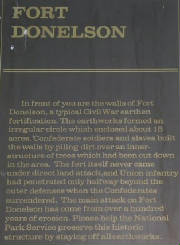
|
| (Click to Enlarge) |
On February 4-5, 1862, Grant landed
his divisions in two different locations, one on the east bank of the Tennessee River to prevent the garrison at Fort Henry from escaping or receiving reinforcements from Fort
Donelson and the other to occupy the high ground on the Kentucky side to ensure the fall of both Forts Heiman and Henry. After gunboats under the
command of Union naval Flag Officer Andrew H. Foote began bombarding the forts, Confederate Brig. Gen. Lloyd Tilghman, realizing
that Fort Heiman could not be held, recalled
the 1,100 troops building the fort to cross the river and assist the nearly 2,000 soldiers defending Fort Henry. The Confederates hoped that the
muddy roads would make it impossible for the Union army to set up artillery on the partially completed Fort Heiman.
On February 6, Tilghman surrendered
Fort Henry
after 70 minutes of bombardment, because it was surrounded by rising water and could not be supported by infantry. Tilghman
decided to withdraw all troops from Fort Henry
to Fort Donelson
(11 miles away) with the exception of one battery which he left behind to delay the Union assault and secure his retreat.
After the capture of both Fort Henry and
the uncompleted Fort Heiman,
the latter was occupied by troops under Brig. Gen. Lew Wallace on February 6. Thus, the surrender of Forts Heiman and Henry
enabled the Federals' wooden gunboats to ascend the Tennessee River south to Muscle Shoals, Alabama,
and set the stage for Grant's successful assault against Fort Donelson 11 miles to the east on the Cumberland
River.
The Approach and Engagement at Fort Donelson
| Evening, Feb. 14 |
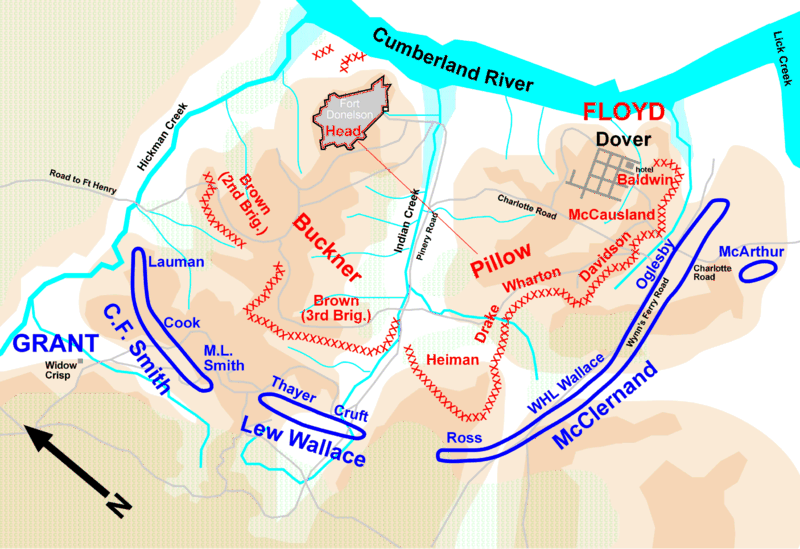
|
| (Click to Enlarge) |
(Right) Map of Union and Confederate Battlefield Positions on the evening
of February 14, 1862.
The morning of February 14 dawned cold
and quiet. Early in the afternoon a furious roar broke the stillness, and the earth began to shake. Andrew H. Foote's Union
gunboat fleet, consisting of the ironclads St. Louis, Pittsburgh, Louisville and Corondolet, and the timberclads Conestoga
and Tyler, had arrived from Fort Henry via the Tennessee and Ohio Rivers and were exchanging "iron valentines" with the eleven
big guns in the Southern water batteries.
During this one and one-half hour duel the Confederates wounded Foote and
inflicted such extensive damage upon the gunboats that they were forced to retreat. The hills and hollows echoed with cheers
from the southern soldiers.
| Confederate Breakout Attempt |
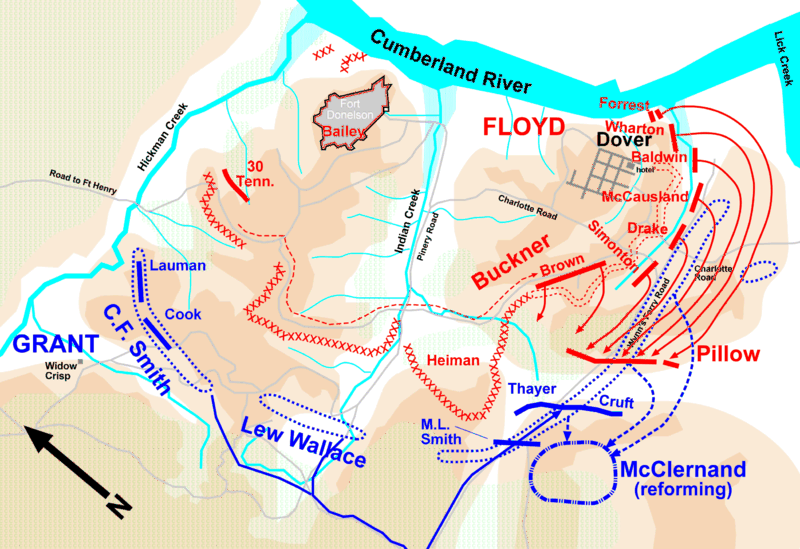
|
| (Click to Enlarge) |
(Right) Map of Confederate breakout attempt, morning February 15, 1862.
The Confederate generals—John
Floyd, Gideon Pillow, Simon Buckner and Bushrod Johnson—also rejoiced; but sober reflection revealed another danger.
Grant was receiving reinforcements daily and had extended his right flank almost to Lick Creek to complete the encirclement
of the Southerners. If the Confederates did not move quickly, they would be starved into submission. Accordingly, they massed
their troops against the Union right, hoping to clear a route to Nashville and safety. The battle on February 15 raged all
morning, the Union Army grudgingly retreating step by step. Just as it seemed the way was clear, the Southern troops were
ordered to return to their entrenchments—a result of confusion and indecision among the Confederate commanders. Grant
immediately launched a vigorous counterattack, retaking most of the lost ground and gaining new positions as well. The way
of escape was closed once more.
Floyd and Pillow turned over command of Fort Donelson to Buckner and slipped
away to Nashville with about 2,000 men. Others followed cavalryman Col. Nathan Bedford Forrest across swollen Lick Creek.
That morning, February 16, Buckner asked Grant for terms. Grant's answer was short and direct: "No terms except an unconditional
and immediate surrender can be accepted." Buckner surrendered.
| Fort Donelson Civil War Battlefield |
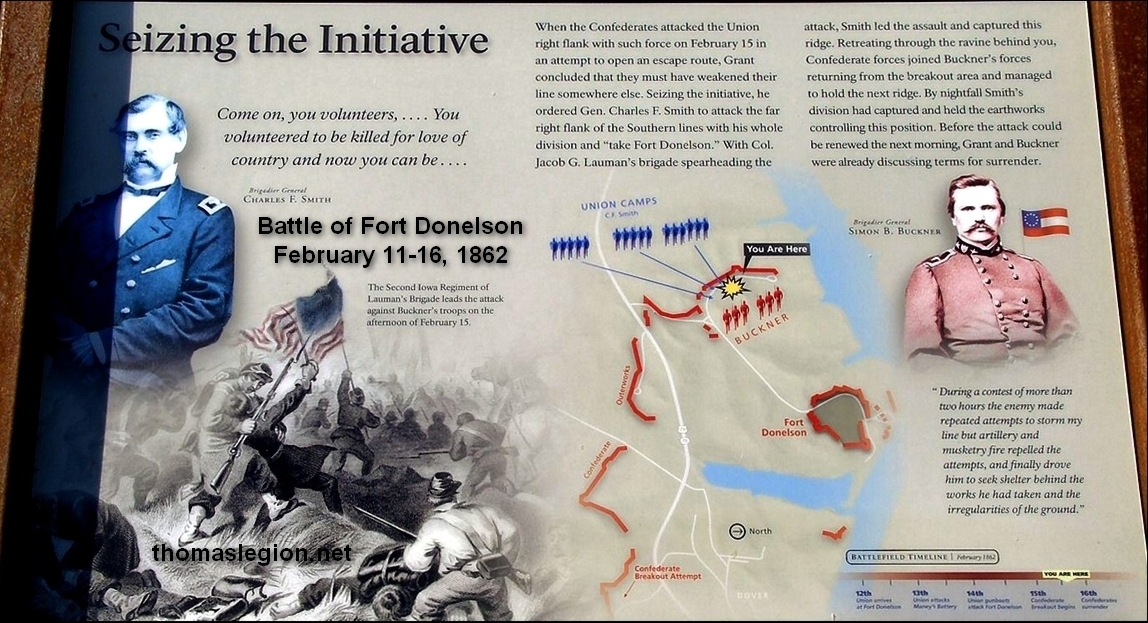
|
| Battle of Fort Donelson History Marker |
| Union counterattack Fort Donelson |
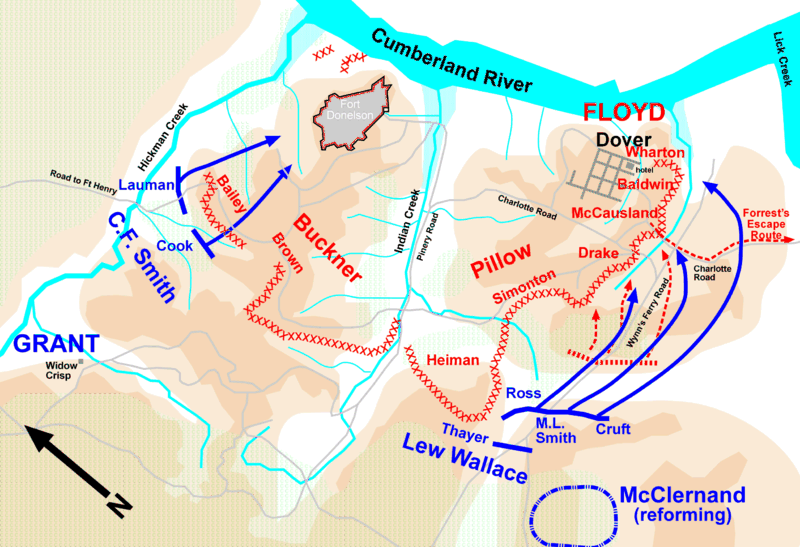
|
| Union and Confederate movements during Battle of Fort Donelson |
(Right) Map of Union counterattack, afternoon February 15, 1862.
On the morning of February 16, Buckner sent a note to Grant requesting an
armistice and terms of surrender. The note first reached General Charles F. Smith. Smith stated "I'll make no terms with Rebels
with arms in their hands-my terms are unconditional and immediate surrender". When the note finally reached Grant Smith again
told Grant "no terms to the Rebels". Buckner had expectations that Grant would offer generous terms because of their previous
relationship. In 1854, Grant had lost a command in California allegedly because of a drinking problem, and U.S. Army officer
Buckner had loaned him money to get home after his resignation.
But Grant showed he had no mercy toward men who had rebelled against the Union.
His reply was one of the most famous quotes from the war, giving him his nom de guerre of "Unconditional Surrender":
Sir: Yours of this date proposing Armistice, and appointment of Commissioners, to settle terms of Capitulation is just received.
No terms except unconditional and immediate surrender can be accepted.
I propose to move immediately upon your works.
I
am Sir: very respectfully
Your obt. sevt.
U.S. Grant
Brig. Gen.
| River Battery at Fort Donelson |
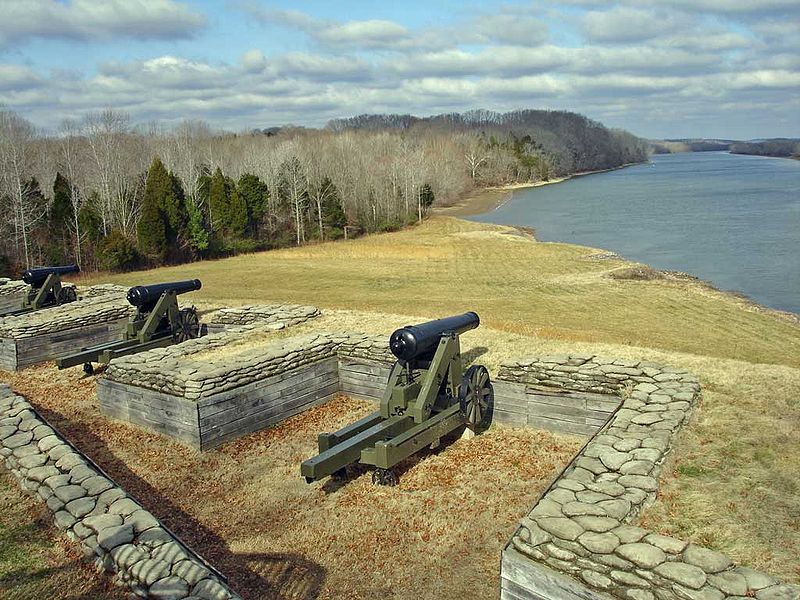
|
| Lower River overlooking the Cumberland River |
| The Escape |
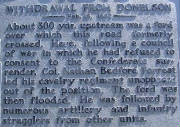
|
| (Click to Enlarge) |
Aftermath
Soon after the surrender, civilians and relief agencies rushed to assist the
Union Army. The U.S. Sanitary Commission was one of the first to provide food, medical supplies, and hospital ships to transport
the wounded. Many civilians came in search of loved ones or to offer support. Although not officially recognized as nurses,
women such as Mary Bickerdyke cared for and comforted sick and wounded soldiers.
| Fort Donelson Attack |
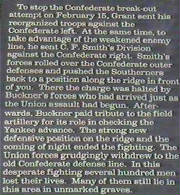
|
| (Click to Enlarge) |
After the fall of Fort Donelson on the Cumberland River on February 16, the
two major water transportation routes in the Confederate west, bounded by the Appalachians on the east and the Mississippi
River on the west, became Union highways for movement of troops and material.
And with the capture of Fort Donelson and its sister fort, Henry, the North
had not only won its first great victory, it had also gained a new hero—"Unconditional Surrender" Grant, who was promoted
to major general. Subsequent victories at Shiloh, Vicksburg, and Chattanooga would lead to his appointment as lieutenant general and commander of all Union Armies. Robert E. Lee's surrender
at Appomattox would send Grant to the White House.
Following the capitulation of Fort Donelson, the South was forced to give
up southern Kentucky and much of Middle and West Tennessee. The Tennessee and Cumberland Rivers, and railroads in the area,
became vital Federal supply lines. Nashville was developed into a huge supply depot for the Union army in the west. The heartland
of the Confederacy was opened, and the Federals would press on until the "Union" became a fact once more.
"The weather was intensely cold; a great many of the men were already
frost-bitten, and it was the opinion of the generals that the infantry could not have passed through the water and have survived
it." Nathan Bedford Forrest, Colonel, Commanding Forrest's Regiment of Cavalry at the Battle of Fort Donelson
| Forts Donelson and Henry Map |
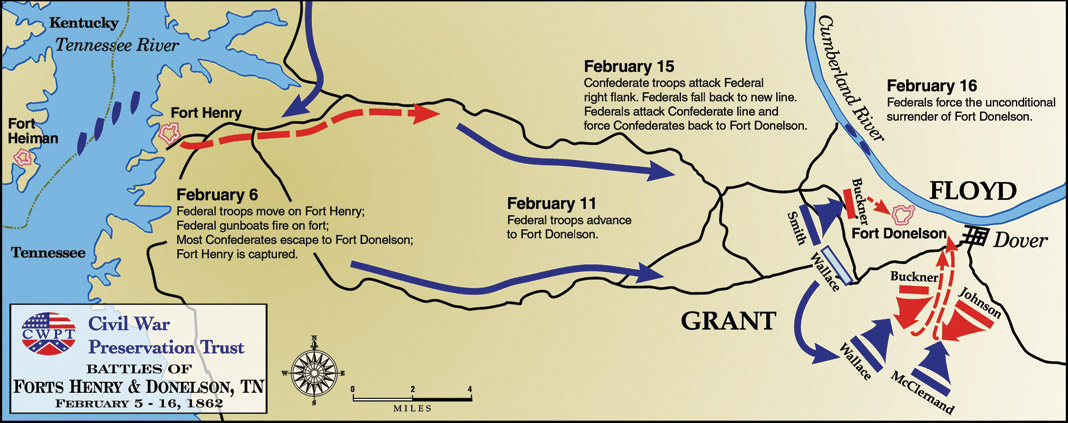
|
| Fort Donelson and Fort Henry Battlefield Map |
Fort Donelson:
United States of America [Union] Order
of Battle
Brigadier General U.S.
Grant, Commanding
First Division (Brigadier General John A. McClernand)
|
1st Brigade (Oglesby)
8th, 18th, 29th, 30th, 31st Illinois Infantry
Battery D, E, 2d Illinois Light Artillery
Companies A, B, 2d Illinois Cavalry
Company C, 2d US Cavalry
Company I, 4th US Cavalry
Carmichael's
Illinois Cavalry
O'Harnett's Illinois Cavalry
Stewart's Illinois
Cavalry |
2d Brigade (W.H.L. Wallace)
11th, 20th, 45th, 48th Illinois Infantry
Battery B, D, 1st Illinois
Light Artillery
4th Illinois Cavalry
3d Brigade (Morrison passed to W.H.L. Wallace)
17th, 49th Illinois Infantry
|
Second Division (Brigadier General Charles F. Smith)
|
1st Brigade (McArthur)
9th, 12th, 41st Illinois Infantry
3d Brigade (Lauman)
25th
Indiana Infantry
2d, 7th, 14th Iowa Infantry
Birge's Western Sharpshooters
|
2d Brigade (Cook)
Batteries D, H, K Missouri Light Artillery
7th, 50th Illinois Infantry
12th Iowa Infantry
13th Missouri
Infantry
4th Brigade (M.L. Smith)
8th Missouri
Infantry
11th Indiana Infantry |
Third Division (Brigadier General L. Wallace)
|
1st Brigade (Cruft)
31st, 44th Indiana Infantry
17th, 25th Kentucky
Infantry
3d Brigade (Thayer)
1 st Nebraska Infantry
58th,
68th, 76th Ohio Infantry |
2d Brigade (attached to 3d Brigade)
46th, 57th, 58th Illinois Infantry
Not Brigaded
Company A, 32nd Illinois Infantry
Battery
A, 1st Illinois (Chicago Light Artillery) |
US Navy
Flag Officer Andrew H. Foote, USN, Commanding
Naval Fleet Fort Donelson
|
St. Louis (Paulding); Carondelet (Walke);
Louisville (Dove); Pittsburg (Thompson); Tyler (Gwinn); Conestoga (Phelps) |
Fort Donelson: Confederate States of America Order of
Battle
Brigadier General John B. Floyd, Commanding
Brigadier General Gideon J. Pillow's Division
|
Colonel Heiman's Brigade
10th,
30th, 42nd, 48th, 53d Tennessee
Infantry
27th Alabama
Infantry
Maney's Tennessee Battery Light Artillery
Colonel
Simonton's Brigade
1st, 3d Mississippi Infantry
7th Texas Infantry
8th Kentucky Infantry
Colonel
Wharton's Brigade
51st, 56th Virginia Infantry |
Colonel Drake's Brigade
4th
Mississippi Infantry
15th Arkansas Infantry
26th Alabama Infantry ( 2 companies)
Colonel
Baldwin's Brigade
26th Tennessee Infantry
20th, 26th Mississippi
Infantry
|
Artillery
Guy's Battery, Goochland (VA) Light Artillery
Green's Tennessee
Battery Light Artillery
French's
Virginia Battery
Light Artillery
Brigadier General Simon B. Buckner's Division
|
Colonel Brown's Brigade
3d,
18th, 32nd Tennessee Infantry
Porter's Tennessee Battery
Light Artillery
Graves' Cumberland
Kentucky Light Artillery |
Colonel Baldwin's Brigade
2d Kentucky Infantry
14th Mississippi Infantry
41st Tennessee Infantry
Jackson's Virginia Battery Light Artillery |
Colonel Nathan B. Forrest's Cavalry Brigade
|
3d Tennessee Cavalry Regiment
9th Tennessee Cavalry
Battalion
1st Kentucky Cavalry Regiment |
Colonel John W. Head's Fort Donelson Garrison Units
|
30th, 49th, 50th Tennessee Infantry
Maury's Tennessee Battery
Light Artillery (Ross)
Taylor's
Company Tennessee Light Artillery
(Stankiewicz)
Water Battery
Heavy Artillery (Culbertson) |
| Location of Forts, Henry, Donelson, and Heiman |
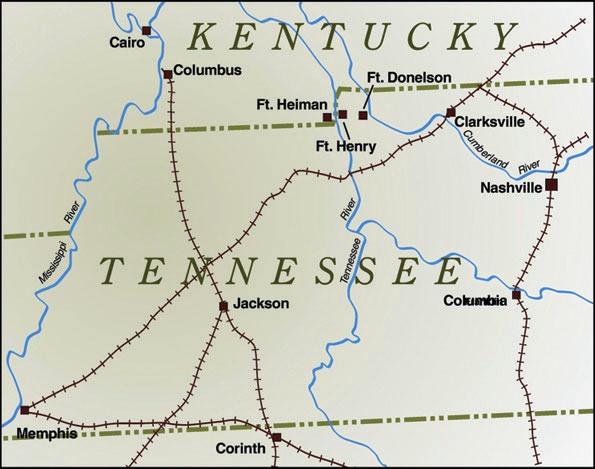
|
| Civil War Preservation Trust Map |
Fort Donelson National Cemetery
| Poem, Bivouac of the Dead |
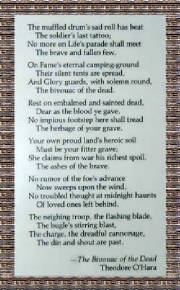
|
| (Click to Enlarge) |
| Fort Donelson National Cemetery |
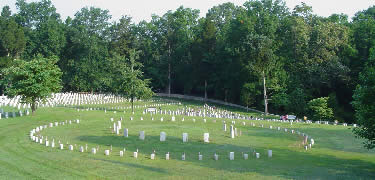
|
| (Tennessee) |
In July 1862, Congress passed legislation giving the President of the United States
the authority to purchase land for the establishment of cemeteries “for soldiers who shall die in the service of their
country”.
The legislation effectively began the national cemetery system. In 1863, the Union Army abandoned the Confederate
works and constructed a new fortification on the ground that became the cemetery site. A freedmen's community developed around
the new Union fort. Four years later (1867), this same site was selected for the establishment of the Fort Donelson National
Cemetery (15.34 acres) and 670 Union soldiers were reinterred here. These
soldiers (which included 512 unknowns) had been buried on the battlefield, in local cemeteries, in hospital cemeteries, and
in nearby towns. (These totals include five known and nine unknown soldiers from the United States Colored Troops.)
The high percentage of unknown soldiers (512) can be attributed to the "haste in cleaning up the battlefield"
and the fact that civil war soldiers did not carry government-issued identification. In 1867, Fort
Donelson Cemetery was established as the
final resting for Union soldiers and sailors initially buried in the Fort
Donelson area. Today the national cemetery contains both Civil War veterans
and veterans who have served the United States
since that time. Furthermore, many spouses and dependent children are also buried here. The cemetery is presently unavailable for additional
burials.
| Fort Donelson Battle Map |
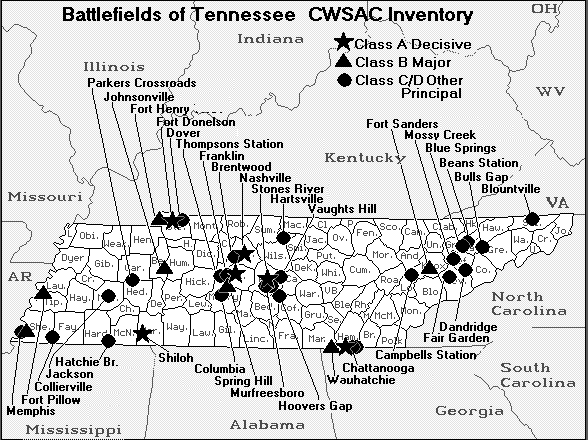
|
| Civil War Fort Donelson Battlefield Map |
(Sources and related reading below.)
Recommended Reading: Men
of Fire: Grant, Forrest, and the Campaign That Decided the Civil War. From Publishers Weekly: The bloody
February 1862 Union victory at Fort Donelson on Tennessee's Cumberland River is remembered as the Union's first big success—and
as the battle in which Ulysses S. Grant held firm for Confederate unconditional surrender. Former journalist Hurst (Nathan
Bedford Forrest: A Biography) attempts to make the case that Grant's western theater victory at Donelson indelibly shaped
his military career, as well as that of Confederate Lt. Col. Nathan Bedford Forrest, and that the battle turned the tide of
the Civil War unalterably in the North's favor. Writing forcefully and engagingly, Hurst does a thorough job of reconstructing
the military aspects of the battle and never shies away from illuminating the war's horror. Continued below.
His focus is on Grant, the Confederate generals who faced him (John Floyd, Gideon Pillow, Simon Buckner
and Bushrod Johnson) and the ever-aggressive Forrest, best known for his battlefield viciousness and his postwar role in creating
the Ku Klux Klan. It's a stretch, though, to postulate that the 1862 victory at Donelson propelled the Union to victory more
than three years later. Certainly, as Hurst says, western theater action often is overlooked in assessing the Civil War. But
one can't ignore the impact on the war's outcome of the massive battles of Antietam, Gettysburg, Wilderness and Cold Harbor
that came after Donelson. AWARDED 5 STARS by americancivilwarhistory.org
Related Studies:
Recommended Reading:
Shiloh and the Western Campaign of 1862. Review: The bloody and decisive
two-day battle of Shiloh (April 6-7, 1862) changed the entire course of the American Civil
War. The stunning Northern victory thrust Union commander Ulysses S. Grant into the national spotlight, claimed the life of
Confederate commander Albert S. Johnston, and forever buried the notion that the Civil War would be a short conflict. The
conflagration at Shiloh had its roots in the strong Union advance during the winter of 1861-1862 that resulted in the capture
of Forts Henry and Donelson in Tennessee. Continued below.
The offensive collapsed General
Albert S. Johnston advanced line in Kentucky and forced him to withdraw all the way to northern Mississippi.
Anxious to attack the enemy, Johnston began concentrating Southern forces at Corinth,
a major railroad center just below the Tennessee border.
His bold plan called for his Army of the Mississippi to march north and destroy General Grant's
Army of the Tennessee before it could link up with another
Union army on the way to join him. On the morning of April 6, Johnston boasted to his subordinates,
"Tonight we will water our horses in the Tennessee!" They
nearly did so. Johnston's sweeping attack hit the unsuspecting Federal camps at Pittsburg Landing
and routed the enemy from position after position as they fell back toward the Tennessee River.
Johnston's sudden death in the Peach Orchard, however, coupled
with stubborn Federal resistance, widespread confusion, and Grant's dogged determination to hold the field, saved the Union
army from destruction. The arrival of General Don C. Buell's reinforcements that night turned the tide of battle. The next
day, Grant seized the initiative and attacked the Confederates, driving them from the field. Shiloh
was one of the bloodiest battles of the entire war, with nearly 24,000 men killed, wounded, and missing. Edward Cunningham,
a young Ph.D. candidate studying under the legendary T. Harry Williams at Louisiana
State University, researched and wrote Shiloh and the Western Campaign of 1862 in 1966. Although it remained unpublished, many Shiloh
experts and park rangers consider it to be the best overall examination of the battle ever written. Indeed, Shiloh
historiography is just now catching up with Cunningham, who was decades ahead of modern scholarship. Western Civil War historians
Gary D. Joiner and Timothy B. Smith have resurrected Cunningham's beautifully written and deeply researched manuscript from
its undeserved obscurity. Fully edited and richly annotated with updated citations and observations, original maps, and a
complete order of battle and table of losses, Shiloh and the Western Campaign of 1862 will
be welcomed by everyone who enjoys battle history at its finest. Edward Cunningham, Ph.D., studied under T. Harry Williams
at Louisiana State
University. He was the author of The Port Hudson Campaign: 1862-1863
(LSU, 1963). Dr. Cunningham died in 1997. Gary D. Joiner, Ph.D. is the author of One Damn Blunder from Beginning to End: The
Red River Campaign of 1864, winner of the 2004 Albert Castel Award and the 2005 A. M. Pate, Jr., Award, and Through the Howling
Wilderness: The 1864 Red River Campaign and Union Failure in the West. He lives in Shreveport,
Louisiana. About the Author: Timothy B. Smith, Ph.D., is author of Champion Hill:
Decisive Battle for Vicksburg (winner of the 2004 Mississippi
Institute of Arts and Letters Non-fiction Award), The Untold Story of Shiloh: The Battle and the Battlefield, and This Great
Battlefield of Shiloh: History, Memory, and the Establishment of a Civil War National Military Park. A former ranger at Shiloh,
Tim teaches history at the University of Tennessee.
Recommended Reading:
Forts Henry and Donelson: The Key to the Confederate Heartland. Description: The Twin Rivers Campaign, aka the Union
campaign against Fort Henry and Fort Donelson, was
a direct result of Gen. Winfield Scott’s Anaconda Plan… But, after the Twin
River forts were captured by a Federal army-navy force and coupled with the fall
of Nashville, the Union enjoyed a fresh and much needed momentum.
The fall of the forts signaled the beginning of the Confederate collapse in the West, which ultimately decided the war. Continued
below.
Benjamin Franklin Cooling, author
of several Civil War studies, conveys the actions of both Federal and Confederate authorities before and during the campaign,
and applies the exact words of the frontline soldiers’ to the subject. The campaign is described in good detail,
and with great writing. With little written about this dramatic and pivotal campaign, it is a great joy to read Mr. Cooling's
book. The maps in this book, while not the best, are well above average. They cover the fighting at the forts in very
good detail. The illustrations are helpful as well. I encourage Civil War buffs to read this book and enjoy the history of
this rarely written about pivotal campaign.
Recommended Reading:
Naval Campaigns of the Civil War. Description: This analysis of naval engagements during the War
Between the States presents the action from the efforts at Fort Sumter during the secession of South Carolina in 1860, through
the battles in the Gulf of Mexico, on the Mississippi River, and along the eastern seaboard, to the final attack at Fort Fisher
on the coast of North Carolina in January 1865. This work provides an understanding of the maritime problems facing both sides
at the beginning of the war, their efforts to overcome these problems, and their attempts, both triumphant and tragic, to
control the waterways of the South. The Union blockade, Confederate privateers and commerce raiders are discussed, as is the
famous battle between the Monitor and the Merrimack. Continued
below…
An overview
of the events in the early months preceding the outbreak of the war is presented. The chronological arrangement of the campaigns
allows for ready reference regarding a single event or an entire series of campaigns. Maps and an index are also included.
About the Author: Paul Calore, a graduate of Johnson and Wales University,
was the Operations Branch Chief with the Defense Logistics Agency of the Department of Defense before retiring. He is a supporting
member of the U.S. Civil War Center and the Civil War Preservation Trust and has also written Land Campaigns of the Civil
War (2000). He lives in Seekonk, Massachusetts.
Recommended Reading:
Naval Strategies of the Civil War: Confederate
Innovations and Federal Opportunism. Description:
One of the most overlooked aspects of the American Civil War is the naval strategy played out by the U.S. Navy and the fledgling
Confederate Navy, which may make this the first book to compare and contrast the strategic concepts of the Southern Secretary
of the Navy Stephen R. Mallory against his Northern counterpart, Gideon Welles. Both men had to accomplish much and were given
great latitude in achieving their goals. Mallory's vision of seapower emphasized technological innovation and individual competence
as he sought to match quality against the Union Navy's (quantity) numerical superiority. Welles had to deal with more bureaucratic
structure and to some degree a national strategy dictated by the White House. Continued below...
The naval blockade
of the South was one of his first tasks - for which he had but few ships available - and although he followed the national
strategy, he did not limit himself to it when opportunities arose. Mallory's dedication to ironclads is well known, but he
also defined the roles of commerce raiders, submarines, and naval mines. Welles's contributions to the Union effort were rooted
in his organizational skills and his willingness to cooperate with the other military departments of his government. This
led to successes through combined army and naval units in several campaigns on and around the Mississippi River.
Recommended Reading: Six Armies in Tennessee:
The Chickamauga and Chattanooga
Campaigns (Great Campaigns of the Civil War). Description: When Vicksburg fell to Union
forces under General Grant in July 1863, the balance turned against the Confederacy in the trans-Appalachian theater. The
Federal success along the river opened the way for advances into central and eastern Tennessee,
which culminated in the bloody battle of Chickamauga and then a struggle for Chattanooga. Chickamauga
is usually counted as a Confederate victory, albeit a costly one.
That battle—indeed the entire campaign—is marked
by muddle and blunders occasionally relieved by strokes of brilliant generalship and high courage. The campaign ended significant
Confederate presence in Tennessee
and left the Union poised to advance upon Atlanta and the
Confederacy on the brink of defeat in the western theater.
Consider Also: CIVIL WAR IN WEST
SLIP CASES: From Stones River to Chattanooga [BOX SET], by Peter Cozzens (1528 pages) (University of Illinois Press).
Description: This trilogy very competently fills in much needed analysis and detail
on the critical Civil War battles of Stones River,
Chickamauga and Chattanooga. "Cozzens' comprehensive study of these three great battles has set a new standard in Civil War
studies....the research, detail and accuracy are first-rate."
Recommended Reading: Mississippi River Gunboats of the American Civil War 1861-65 (New Vanguard). Description: At the
start of the American Civil War, neither side had warships on the Mississippi River. In the
first few months, moreover, both sides scrambled to gather a flotilla, converting existing riverboats for naval use. These
ships were transformed into powerful naval weapons despite a lack of resources, trained manpower and suitable vessels. Continued
below.
The creation of a river fleet was a miracle of ingenuity, improvisation and logistics, particularly for
the South. This title describes their design, development and operation throughout the American Civil War.
Sources: National Park Service;
Fort Donelson National Battlefield; Library of Congress; National Archives and Records Administration; Official Records of
the Union and Confederate Navies; Official Records of the Union and Confederate Armies; Civil War Preservation Trust (CWPT);
Vicksburg National Military Park; Cooling, Benjamin Franklin, The Campaign for Fort Donelson, U.S. National Park Service and
Eastern National, 1999; Eicher, David J., The Longest Night: A Military History of the Civil War, Simon & Schuster, 2001;
Esposito, Vincent J., West Point Atlas of American Wars, Frederick A. Praeger, 1959; Foote, Shelby, The Civil War, A Narrative:
Fort Sumter to Perryville, Random House, 1958; Gott, Kendall D., Where the South Lost the War: An Analysis of the Fort Henry—Fort
Donelson Campaign, February 1862, Stackpole books, 2003; Kennedy, Frances H., Ed., The Civil War Battlefield Guide, 2nd ed.,
Houghton Mifflin Co., 1998; McPherson, James M., Battle Cry of Freedom: The Civil War Era (Oxford History of the United States),
Oxford University Press, 1988; Nevin, David, and the Editors of Time-Life Books, The Road to Shiloh: Early Battles in the
West, Time-Life Books, 1983; Woodworth, Steven E., Nothing but Victory: The Army of the Tennessee, 1861–1865, Alfred
A. Knopf, 2005.
|

